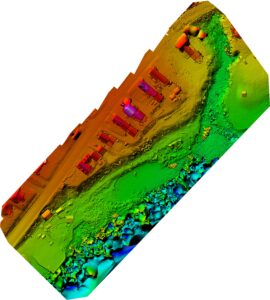From Blueprints to Reality: Leveraging Drones for Construction Monitoring
In an era where technological innovation is transforming industries, the construction sector is experiencing a revolution, thanks to the integration of drones into construction monitoring practices. These Unmanned Aerial Vehicles (UAVs) have evolved to play a pivotal role in overseeing construction projects. Leveraging cutting-edge capabilities to optimize efficiency, improve safety, and provide real-time data insights. In this comprehensive article, we delve into the profound impact of drones in construction monitoring.

Drones in Construction Monitoring: A New Era
Traditionally, construction site monitoring relied heavily on manual surveys and ground-level inspections, offering only limited perspectives of ongoing projects. The emergence of drones in the construction industry has ushered in a new era, providing an aerial viewpoint that significantly enhances project supervision.
These observations are substantiated by industry leaders and experts, including a report by the American Bar Assoication. Which highlights the transformative effect of drones on construction site monitoring, improving productivity and safety simultaneously. [Use of Drones on Construction Projects: Legal and Contractual Considerations]
Drones: Transforming Construction Oversight
Drones are often equipped with advanced imaging technology. They have the capacity to capture high-resolution images and videos from various angles. This comprehensive aerial perspective empowers project managers to monitor construction sites holistically, offering real-time insights into progress, potential construction challenges, and critical safety concerns.
Recent case studies, such as the one conducted by Turner Construction Company, illustrate the tangible benefits of using drones in construction monitoring. Turner Construction reported improved project timelines, reduced risks, and significant cost savings by integrating drones into their construction projects.
Real-Time Data: The Power of Immediate Information
The integration of drones facilitates the acquisition of real-time data, which proves invaluable for construction project management. These UAVs swiftly capture and transmit data to project stakeholders, ensuring up-to-the-minute information accessibility.
A study published in the Journal of Construction Engineering and Management highlights the advantages of real-time data acquisition through drones in improving construction project performance. The study’s findings underscore the role of drones in enhancing construction site monitoring.
Safety First: Drones in Construction
In the construction industry, safety reigns supreme, and drones play a pivotal role in elevating safety standards on construction sites. Instead of deploying personnel for hazardous inspections or to navigate challenging terrains, drones assume these tasks safely and efficiently, significantly reducing the risk of on-site accidents and injuries.
Moreover, drones actively monitor safety protocols and identify potential safety hazards in real-time. This proactive approach to safety not only mitigates risks but also promotes a culture of safety excellence within construction teams.
A comprehensive analysis by the Occupational Safety and Health Administration (OSHA) recognizes the contribution of drones to enhanced safety in construction, emphasizing the reduction of work-related incidents. Osha is now allowed to use drones for safety inspections with property owners permission.
Efficiency and Cost Savings
In a domain where every moment and dollar count. Drones deliver exceptional efficiency and cost savings. By providing real-time data, project managers can promptly identify and address issues, preventing costly project delays.
Additionally, drones streamline surveying and mapping processes.Generating precise 3D models of construction sites. These models are then compared to initial blueprints, facilitating early detection of deviations and ensuring that projects remain within budget and on schedule.
Research by McKinsey & Company, a global management consulting firm, supports the claim that drones improve construction project efficiency and cost-effectiveness. Their report highlights the role of drones in minimizing budget overruns and project delays.
Environmental Stewardship
Drones also contribute positively to environmental stewardship within construction projects. They monitor environmental compliance, such as erosion control measures and the preservation of vegetation. By swiftly identifying and addressing environmental concerns, construction projects can minimize their ecological footprint and contribute to sustainable practices.
Reports by environmental agencies and organizations, such as the Environmental Protection Agency (EPA) and the Sierra Club, commend the use of drones for their role in ensuring environmental compliance in construction projects, ultimately benefiting local ecosystems and communities.
Conclusion: Drones Elevate Construction Monitoring
From blueprints to reality, drones have revolutionized construction monitoring. Offering a fresh perspective, real-time data insights, enhanced safety, efficiency, and environmental benefits. Embracing this technology is not just a choice but a necessity for construction companies seeking to thrive in a rapidly evolving industry.
As construction projects continue to grow in complexity and ambition, drones remain at the forefront of innovation. This technology will only become more integral to construction processes, making it essential for construction professionals to harness the power of drones fully.
In a world where technology shapes the future, drones have firmly established themselves as indispensable tools, redefining how construction projects are executed and completed. The sky is no longer the limit; it’s just the beginning of a new era of construction monitoring excellence, driven by drones.
If you would like to know more about the drones in construction.